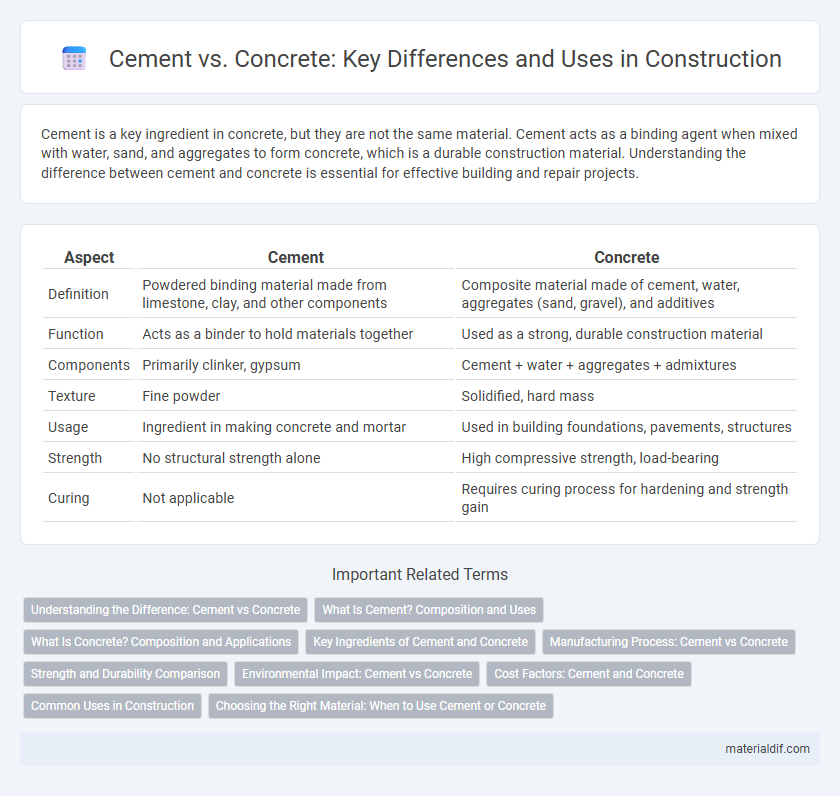Cement is a key ingredient in concrete, but they are not the same material. Cement acts as a binding agent when mixed with water, sand, and aggregates to form concrete, which is a durable construction material. Understanding the difference between cement and concrete is essential for effective building and repair projects.
Table of Comparison
| Aspect | Cement | Concrete |
|---|---|---|
| Definition | Powdered binding material made from limestone, clay, and other components | Composite material made of cement, water, aggregates (sand, gravel), and additives |
| Function | Acts as a binder to hold materials together | Used as a strong, durable construction material |
| Components | Primarily clinker, gypsum | Cement + water + aggregates + admixtures |
| Texture | Fine powder | Solidified, hard mass |
| Usage | Ingredient in making concrete and mortar | Used in building foundations, pavements, structures |
| Strength | No structural strength alone | High compressive strength, load-bearing |
| Curing | Not applicable | Requires curing process for hardening and strength gain |
Understanding the Difference: Cement vs Concrete
Cement is a fine powder made from limestone, clay, and other minerals, acting as a binding agent when mixed with water. Concrete is a composite material consisting of cement, water, aggregates like sand and gravel, and sometimes admixtures, which hardens into a strong, durable building material. Understanding the difference is crucial for construction, as cement alone is not structurally usable without the aggregates that form concrete.
What Is Cement? Composition and Uses
Cement is a fine powder composed primarily of calcium silicates, aluminum, and iron oxides, which acts as a binding agent when mixed with water. It serves as the key ingredient in concrete and mortar, providing strength and durability to construction materials. Widely used in building foundations, roads, and infrastructure projects, cement's chemical properties enable it to harden and set over time, forming a solid matrix.
What Is Concrete? Composition and Applications
Concrete is a composite construction material primarily composed of cement, aggregates (sand and gravel), and water, which hardens over time through a chemical process called hydration. It exhibits high compressive strength, making it ideal for structural elements such as foundations, beams, columns, and pavements. Widely utilized in infrastructure projects, concrete's versatility extends to applications in residential, commercial, and industrial buildings.
Key Ingredients of Cement and Concrete
Cement primarily consists of clinker, gypsum, and supplementary materials like fly ash or slag, which act as binding agents in construction. Concrete is a composite material made by mixing cement, water, aggregates (sand, gravel, or crushed stone), and sometimes admixtures to enhance performance. The key distinction lies in cement being the binder, while concrete is the final product used structurally, relying on aggregates for strength and volume.
Manufacturing Process: Cement vs Concrete
Cement is produced by heating limestone and clay at high temperatures to form clinker, which is then ground into a fine powder. Concrete is manufactured by mixing cement with aggregates, water, and often admixtures to create a malleable composite material. The key difference lies in cement being a binder component, while concrete is the final structural product used in construction.
Strength and Durability Comparison
Concrete exhibits greater strength and durability compared to cement alone due to its composite nature, which includes aggregates and water that enhance its structural integrity. Cement acts as a binder but gains significant strength when combined with sand, gravel, and proper curing, resulting in concrete capable of withstanding heavy loads and environmental wear. The compressive strength of concrete typically ranges from 20 to 40 MPa, far surpassing that of cement paste, and its durability is enhanced by its resistance to weathering, chemical attack, and freeze-thaw cycles.
Environmental Impact: Cement vs Concrete
Cement production accounts for approximately 8% of global CO2 emissions, making it a significant contributor to environmental pollution compared to concrete, which is a composite material made of cement, aggregates, and water. Concrete's environmental impact depends largely on the cement content, with lower cement ratios reducing carbon footprint while maintaining structural integrity. Innovations like supplementary cementitious materials (SCMs) such as fly ash and slag help lower the environmental impact of concrete by reducing the need for traditional Portland cement.
Cost Factors: Cement and Concrete
Cement typically costs more per ton due to its refined manufacturing process, while concrete is more cost-effective because it combines cement with aggregates like sand and gravel, reducing overall expenses. The price of concrete varies significantly based on the mix design, transportation, and labor costs, making it a flexible option for various construction projects. Choosing concrete over pure cement usually results in lower material costs and enhanced structural benefits.
Common Uses in Construction
Cement serves as the key binding agent in concrete, which is widely used in construction for creating foundations, slabs, and structural frameworks. Concrete is preferred for its durability and versatility, making it ideal for sidewalks, bridges, and high-rise buildings. Cement alone is rarely used without aggregates and water, while concrete offers a complete building material essential for load-bearing applications.
Choosing the Right Material: When to Use Cement or Concrete
Cement serves as a key binding agent in concrete, which combines cement, sand, gravel, and water to form a durable construction material. Use cement alone for projects requiring adhesive properties or small-scale repairs, whereas concrete is ideal for foundations, sidewalks, and large structural applications due to its strength and versatility. Selecting the right material depends on the specific requirements of load-bearing capacity, durability, and environmental exposure.
Cement vs Concrete Infographic

 materialdif.com
materialdif.com